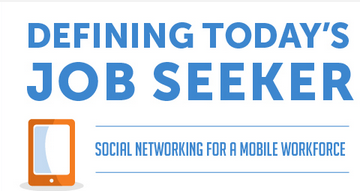aNewDomain.net — The data is in. It’s conclusive. Baby boomers and older Gen X workers are looking for jobs, but in all the wrong places. Read below for advice from leading employers and find out what the under-40 set knows that you don’t. Here’s David Michaelis with more …
These days Facebook, Twitter and LinkedIn might just help you get your dream job. The signals are finally rising above the noise. Messages about job openings, employers, job cultures, employment brands, employee feedback and referrals are finally beginning to reach people on both sides of the hiring equation. Will social-media mobility actually lead to real social mobility? Will it help with looking for jobs?
Yes.
But if you’re a boomer or an older Gen X-er the data says the way in which you’re looking for jobs is fundamentally flawed. You’re going old school. Read the article and check out the infographic below the fold to make a badly-needed course correction.
The new wave
Baby boomers — the generation of people born, roughly, between 1946 and 1964 — just are not exploiting their social networks or using their smartphones in ways that could help them look for jobs. Or use social networks and smartphones to learn about and apply for jobs, data shows. Even older Gen X-ers, those born between 1964 and 1974, are looking for jobs in all the wrong places — and in all the wrong ways.
Richard Eisenberg at Forbes points out that:
Only 22 percent of ‘social job seekers’ — people who actively use social networking to look for employment or explore new employment opportunities — are 40 to 54. Just 9 percent of social job seekers are 55 or older. By contrast, 40 percent of social job seekers are in their 30s … and 30 percent are (in the) 18 to 29 (age group).”
And consider Google’s new resume …
In a Q&A interview with Google’s senior vice president of people operations Laszlo Bock, The New York Times’s Tom Friedman fished a few seriously-helpful words of wisdom out of the search giant’s human resources chief. Bock said “the key” is …
… to frame your strengths as: I accomplished X, relative to Y, by doing Z. Most people would write a résumé like this: ‘Wrote editorials for The New York Times.’ Better would be to say: ‘Had 50 op-eds published compared to average of six by most op-ed [writers], as a result of providing deep insight into the following area for three years.’ Most people don’t put the right content on their résumés.”
For the full interview, click here.
So Google laid out its terms. Would you mold your application to one Google exec’s mobile-social advice or will you go your own way?
Is 2014 going to be the year when applying for and getting a job really changes?

Image credit: Wikimedia Commons
One fact worth considering: More than half of those who are employed at present are either actively seeking or open to new job opportunities. And 71 percent of the U.S. labor force — presently employed and unemployed, alike — is actively job-hunting. As Reuters summed it up:
The labor force participation rate, or the proportion of working-age Americans who have a job or are looking for one, hit a six-month high of 63.2 percent. An even broader gauge of labor market health, the percentage of working-age Americans with a job, reached its highest level since the summer of 2009.”
Bottom line: Boomer job hunters who aren’t exploiting Facebook, LinkedIn and Twitter — just 9 percent of people age 50 to 64 use Twitter and only 24 percent of them use LinkedIn, according to Pew Research Center — are missing out on potential opportunities.
Adds a Forbes writer:
The same goes for those who ignore apps for job searching and social networking … and they can’t afford to make these mistakes in today’s job market, particularly if they’ve been out of work for a while … As Federal Reserve Board Chair Janet Yellen said (recently), ‘The share of workers in the labor force who are unemployed and have been looking for work for more than six months … remains as high as any time prior to the Great Recession.’ ”
Ouch. The data suggests younger job applicants simply find more jobs. That makes sense. These applicants know how to use the tech they grew up with — and they’re entering the marketplace in droves. Check out the infographic below to get an idea of the giant disparity between boomers and younger generations in terms of job hunting methods.
For aNewDomain.net, I’m David Michaelis.
Based in Australia, David Michaelis is a world-renowned international journalist and founder of Link Tv. At aNewDomain.net, he covers the global beat, focusing on politics and other international topics of note for our readers in a variety of forums. Email him at DavidMc@aNewDomain.net.

Image credit: Jobvite.com














This is a great essay!
thanks-hope it helps